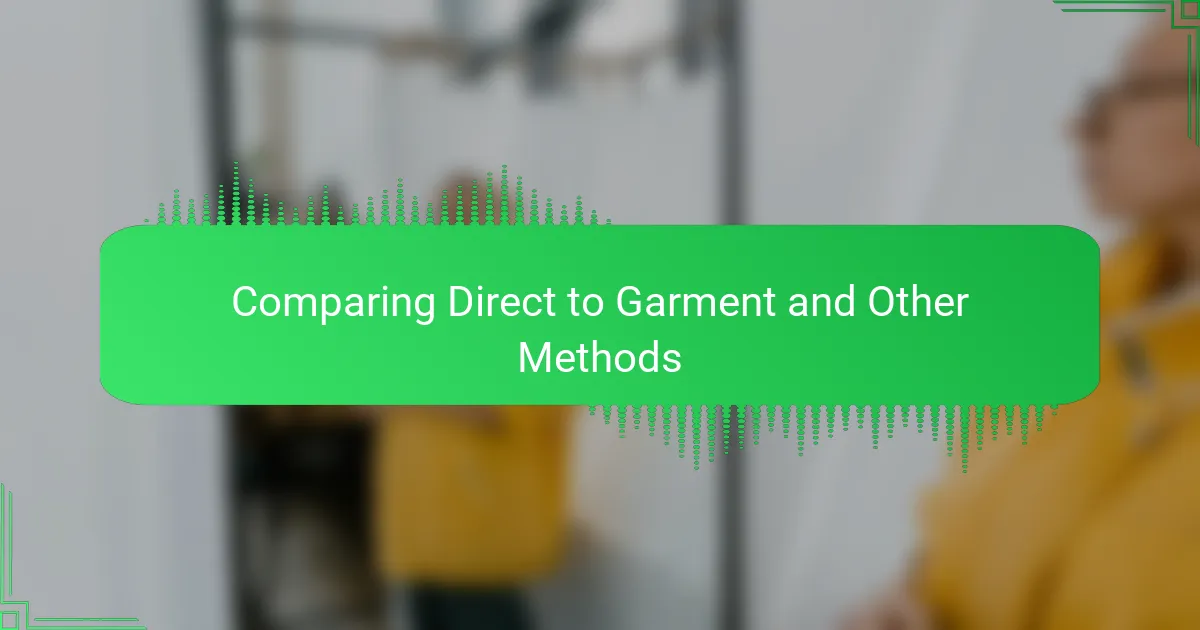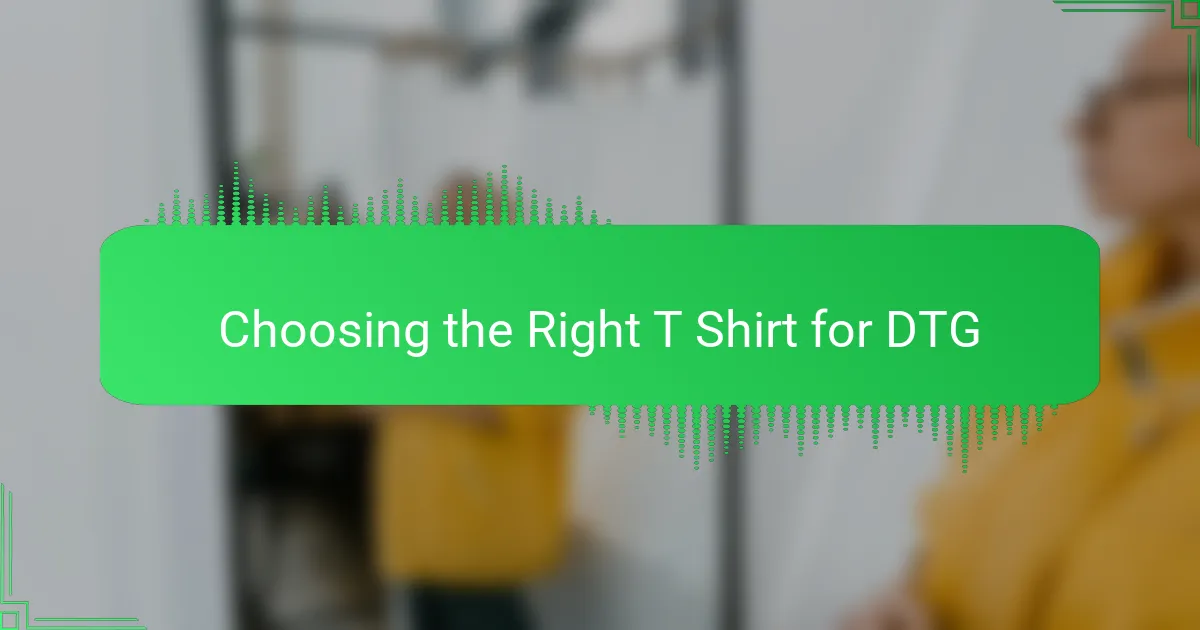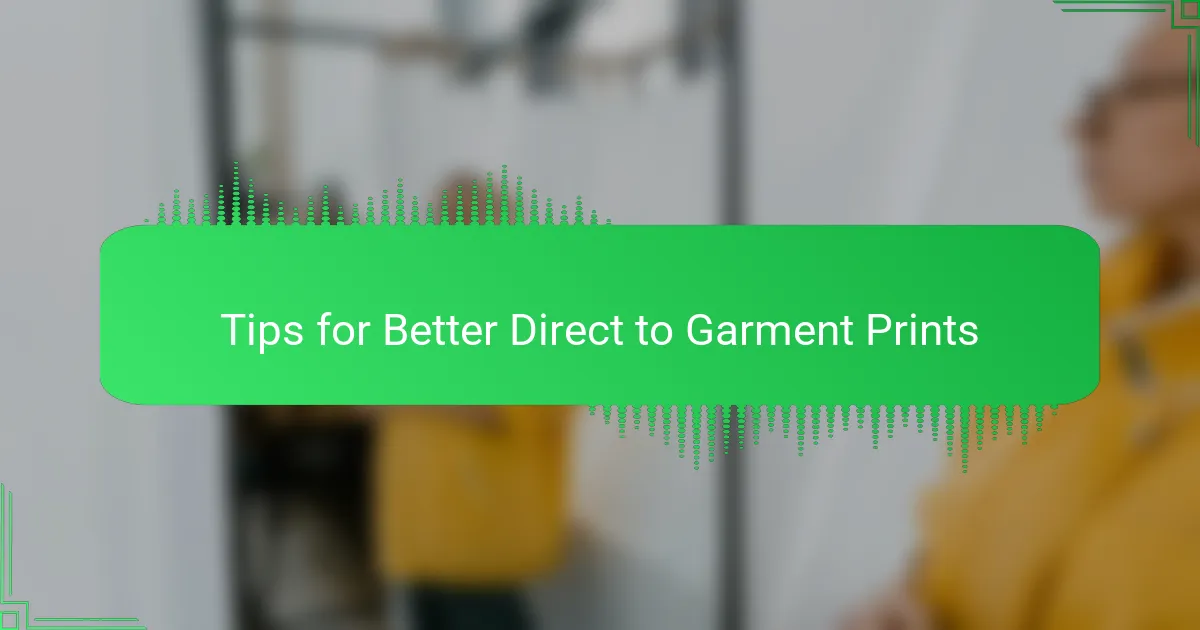Key takeaways
- Direct to Garment (DTG) printing uses water-based inks for detailed, vibrant designs and offers quick setup for small batches.
- Best results are achieved on 100% cotton, providing excellent color quality and a soft feel.
- DTG printing is flexible for on-demand orders without upfront costs, making it ideal for custom designs and limited runs.
- High-resolution artwork and proper design preparation are crucial for achieving sharp, high-quality prints.

What is Direct to Garment
Direct to Garment (DTG) printing is a technique where a digital printer applies ink directly onto the fabric, much like how an inkjet printer works on paper. From my experience, this method stands out because it captures intricate details and vibrant colors that truly bring a design to life, especially for complex or colorful artwork.
What I appreciate most about DTG is how it allows for quick turnaround with minimal setup. Unlike traditional screen printing, you don’t need to create separate screens for each color, which makes it perfect for small batches or one-off designs. Here’s what sets DTG apart for me:
- Uses water-based inks that soak into fabric fibers
- Ideal for detailed, multicolor designs
- No need for screens or stencils
- Supports on-demand printing with fast setup
- Works best on 100% cotton garments
- Produces a softer feel compared to other printing methods

Benefits of Direct to Garment Printing
One thing I’ve noticed with Direct to Garment printing is how incredibly vibrant and detailed the prints turn out. When I first saw a DTG-printed shirt, I was honestly impressed by how crisp every tiny line and color blend appeared. It’s like the artwork truly comes alive on fabric, which for someone like me who loves intricate designs, makes all the difference.
Another benefit that stands out is the softness of the print. Have you ever worn a t-shirt where the design feels stiff or thick? DTG prints are different—they soak into the fabric, so you feel the same softness you expect from your favorite shirt, not a heavy layer on top. For me, this comfort factor makes the shirt more wearable and enjoyable, especially for everyday use.
What I find most practical is the ability to print on demand without wasting time or money on screens. When I was experimenting with limited runs or custom designs, DTG saved me so much hassle. There’s something satisfying about knowing I can order just a few shirts without any big upfront costs, making it easier to test ideas or create personalized gifts. Doesn’t that flexibility sound like a game-changer?

Comparing Direct to Garment and Other Methods
When I first experimented with Direct-to-Garment (DTG) printing, it was clear how different it felt compared to traditional screen printing. The detail and color range DTG offers blew me away, especially for small batches or highly detailed designs. It’s like having an art studio at your fingertips, which I found incredibly empowering as a designer.
However, while DTG excels in detail and convenience, it’s not always the best fit for every project. From my experience, bulk orders with simple designs still favor screen printing for its cost-effectiveness and durability. Here’s a quick comparison based on what I’ve learned:
- DTG Printing: Ideal for complex, full-color designs and small runs; minimal setup; softer feel on the shirt.
- Screen Printing: Best for large orders with fewer colors; highly durable prints; more setup time and cost.
- Heat Transfer: Good for small batches and photographic prints; can feel heavier on fabric; less breathable.
- Sublimation: Perfect for all-over prints on polyester; vibrant colors; limited to light-colored synthetic fabrics.
Each method has its strengths, and choosing the right one really depends on your design goals and production needs.

Choosing the Right T Shirt for DTG
Choosing the right t-shirt for Direct-to-Garment (DTG) printing is more important than many realize. From my experience, 100% cotton shirts deliver the best print quality because the ink adheres smoothly and colors pop vividly. On the other hand, blends like cotton-polyester can save costs but often lead to duller prints and less vibrant detail.
| Material | DTG Print Quality |
|---|---|
| 100% Cotton | Excellent – vibrant colors, smooth ink absorption |
| Cotton-Polyester Blends | Good – less vibrant, may feel slightly rough |
| Polyester | Poor – ink struggles to adhere, colors fade quickly |

Preparing Designs for Direct to Garment
When preparing designs for Direct to Garment (DTG) printing, it’s crucial to focus on image resolution and color fidelity. From my experience, using high-resolution artwork (at least 300 DPI) makes a huge difference in the final print quality, preventing that blurry or pixelated look I’ve seen all too often with less careful preparation. Also, keeping the design within the printable area and using transparent backgrounds helps achieve a cleaner, more professional result.
| Design Aspect | Best Practice for DTG |
|---|---|
| Resolution | Minimum 300 DPI for sharp prints |
| Color Profile | Use RGB to ensure vibrant colors |
| Background | Use transparent backgrounds to avoid unwanted borders |
| File Format | Preferably PNG for transparency and quality |
| Design Placement | Keep within printable area, usually centered and sized appropriately |

My Experience Using Direct to Garment
I found Direct-to-Garment (DTG) printing to be a total game-changer for custom t-shirt design. The level of detail and color vibrancy it delivers really impressed me, especially on complex artwork. While the process is a bit slower compared to screen printing, the flexibility of printing small runs without setup costs makes it perfect for my projects.
| Aspect | My Experience |
|---|---|
| Print Quality | Excellent color detail and vibrancy, especially for intricate designs |
| Speed | Slower printing time, but manageable for small batches |
| Cost Efficiency | No setup costs, great for limited runs or one-offs |
| Fabric Compatibility | Best results on 100% cotton; mixed fabrics vary |
| Durability | Prints hold up well after washing, though less durable than screen print |

Tips for Better Direct to Garment Prints
Getting the best results from Direct-to-Garment (DTG) printing is a bit like fine-tuning a musical instrument—you need precision and care. From my experience, the quality of your artwork plays a huge role; I once rushed a design with low resolution and ended up with a print that looked blurry and dull. Taking time to prepare high-resolution, vibrant designs makes a noticeable difference in how the final print pops on the fabric.
Here are some tips I’ve found invaluable for achieving better DTG prints:
- Use high-resolution images (at least 300 dpi) to ensure sharp details.
- Opt for designs with bold colors and clear contrasts to avoid dull prints.
- Choose 100% cotton or high cotton-blend shirts for better ink absorption.
- Pre-treat the fabric properly to improve ink adhesion and durability.
- Avoid overly dark colors for designs unless you’re using a white base layer.
- Test print small samples before committing to large runs to catch any issues early.
